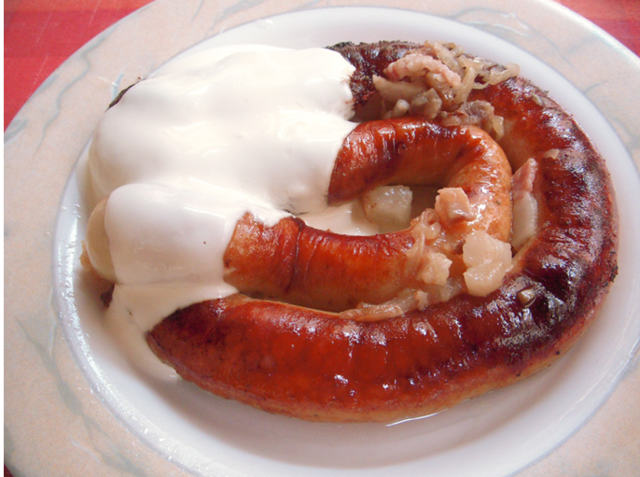Gourmand Dietary Culture
- TOP
- ESSAYS
- Gourmand Dietary Culture
- Potato Sausage
Potato Sausage
vesta No. 77
Bedale Cuisine
To begin with, I want you to take a look at the photograph. You'd probably guess this is a grilled long sausage covered in white sauce, wouldn't you? You'd not be wrong. But this is no ordinary sausage.
This summer, Professor Gourmand, went on a trip to three Baltic countries: Lithuania, Latvia, and Estonia. This photograph shows a potato sausage that was enjoyed by said Professor in a restaurant in Latvia's capital, Vilnius. Lithuania has long been a country known for its agriculture and livestock. Dark rye bread is a staple of the diet, as is are dairy products like cheese and sour cream. In the 17th Century the cultivation of potatoes was introduced, and they were used to feed not only humans, but also pigs, leading to the discovery of pig raising. Pork, potatoes, and dairy produce are the staple ingredients of Lithuanian cooking.
I'll introduce you to the Bedale recipe for making potato sausage. It was originally made when farmers were harvesting pigs, but now it is considered a Lithuanian specialty, and served by restaurants, too.
1) Wash the pig intestine well. Rub the outside of the intestine with garlic, and then leave for at least one day.
2) Grate the peeled potato and leave it to drain.
3) Fry the pork fat with onion, then mix it with the grated potato, fried pork fat, onion, salt, and marjoram into a paste.
4) Pack the paste into the pig intestine. Cook it in a piping hot oven and serve.
The Bedale cuisine I sampled was a potato sausage, boiled and served with sour cream and diced bacon. From the outside, it looks like a regular sausage, but when you cut it open with a knife, the white potato inners appear. The feeling of biting into its grilled outer is the same as that of biting into a regular sausage. But the potato inners of the sausage are slightly sticky and fleshy in texture, with some of the solidity of the pork fat, too. The slightly smoky flavour of the diced bacon it is served with makes it hard to judge whether what you're eating is vegetable or meat-based. It went well with the local 50% alcohol made from distilled honey. Boiled potatoes were served alongside it on a separate plate. Potatoes were the palette cleanser for a dish made of potatoes!
There is another well-known Lithuanian dish called Cepelinai. It is a dish made from grated potato, mincemeat, and cottage cheese, formed into zeppelin-shaped ovals, and boiled or deep fried. The texture is something like that of mochi. Cepelinai take their name from the oval-shaped balloon, the zeppelin. It has been a famous dish since the early 20th Century.
Japan actually has its own sausage not made from animal meat. It is a fish sausage. The fish sausage, which now covers both more traditionally made fish-paste sausages and western-style sausages, was originally a Japanese invention. The fish sausage was popularized in the 1950s. When I was young, the raw material for sausages was fish paste, and bacon was made from whale. The first time I tried sausages or bacon made from pork was around 1960. After that, the economy boomed, and sausages made from animal meat became popular. Problems with whaling meant that whale bacon also became an expensive delicacy.
Nowadays, there aren't many shops left selling fish paste, and there is not much price difference with meat sausages. Trying fish sausages for the first time in a while, I found that eating them with or without skin on, in recipes for regular sausages, they tasted pretty good. Compared to meat sausages, they have a lighter flavour, and are lower in calories. Fish fat is also good for the body, so all round they are better for your health.
What do you think of selling it worldwide as a Japanese specialty sausage?

